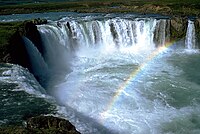

Polarization is a property of light waves that describes the orientation of their oscillations. Polarized light pollution[1] is a subset of the various forms of light pollution referring specifically to polarized light.
In nature, water and water vapor polarize the sunlight (which itself is slightly polarized). By receiving the direction of polarized photons, some species can correct their course during migration. Artificial polarization of natural or artificial light can disrupt the behavior of these species and the ecosystems in which these species play an important role. Pollination is one example of this.
- ^ Gábor Horváth, György Kriska, Péter Malik, Bruce Robertson. (2009) Polarized light pollution: a new kind of ecological photopollution. Frontiers in Ecology and the Environment 7:6, 317-325 / abs/10.1890/080129 Online Access Archived 2017-08-16 at the Wayback Machine 2009/08